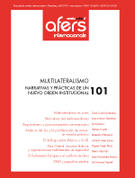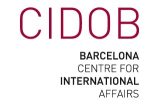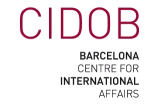Recursos hídricos y organizaciones multilaterales de seguridad en Asia Central
Palabras clave:
agua, recursos hídricos, Asia Central, derechos humanosResumen
Revista CIDOB d’Afers Internacionals, nº 101
Cuatrimestral (abril 2013)
ISSN:1133-6595 | E-ISSN:2013-035X
En la actualidad, Asia Central enfrenta graves conflictos y amenazas, la mayor parte de ellos relacionados con la gestión del agua y de carácter transnacional: crisis humanitarias, millones de personas sin acceso al agua y saneamiento, calentamiento global, sequías, inundaciones, contaminación, problemas étnicos, nepotismo y corrupción en la asignación de recursos hídricos, etc. En julio de 2010, Naciones Unidas proclamó el acceso al agua y su saneamiento como un derecho humano con el propósito de solventar o aminorar dichos conflictos. En la región existen diversas organizaciones de seguridad multilateral que llevan más de dos décadas desarrollando estrategias para hacer frente a los diversos conflictos y amenazas. Dada la gravedad de los actuales conflictos relacionados con el agua, cabe preguntarse sobre el papel de estas organizaciones y si incluyen en su agenda el derecho humano al agua y su saneamiento con el propósito de solucionar los problemas relacionados con la gestión de los recursos hídricos y garantizar a la totalidad de su población el derecho humano al agua.
Citas
Alkire, S. A. «Conceptual Framework for Human Security». CRISE Working Paper, n.º 2 (2003), Queen Elizabeth House, University of Oxford.
Allouche, J. «The governance of Central Asian Waters: National interest versus regional cooperation». Central Asia at the Crossroads (2007) (en línea) http://unidir.org/files/publications/pdfs/central-asia-at-the-crossroads-en-333.pdf
ASOCAM. «Conceptos y Enfoques» (2012). Portal Empoderamiento (en línea) http://www.asocam.org.
Buzan, B.; Waever, O. y De Wile, J. Security: A New Framework for Analysis. Colorado: Lynne Rienner Publishers, 1998, p. 2.
FAO. «Gestión de las Aguas Transfronterizas». (2006) Informe sobre Desarrollo Humano 2006 (en línea) http://hdr.undp.org/en/media/07-Chapter%206_ES1.pdf.
Giordano, Meredith A. y Wolf, Aaron T. «Sharing waters: Post-Rio International Water Management». Natural Resources Forum, n.º 27 (2003), p. 163-171.
Gleick, P.H. «Water and Conflict». International Security, vol. 18, n.º 1 (1993), p. 79-112.
Homer-Dixon, T. «On the Threshold: Environmental Changes as Causes of Acute Conflict». International Security, n.º 16 (1991), p. 76-116.
IFAS (International Fund for Saving the Aral Sea). «Serving the people of Central Asia». Aral Sea Basin Program 3 (2010) (en línea) http://www.ec-ifas.org/about/activities/pbam-3/91-aral-sea-basin-program-3-document.html.
Instituto del Pacífico. «Water and Conflict Chronology», 2012 (en línea) http://worldwater.org/conflict/index.html.
Klemm, W. & Shobair, S. «The Afghan Part of Amu Darya Basin. Impact of Irrigation in Northern Afghanistan on Water Use in the Amu Darya Basin». UNECE (2010) (en línea) http://www.unece.org/fileadmin/DAM/SPECA/documents/ecf/2010/FAO_report_e.pdf.
Kranz, N. et al. «Transboundary River Basin Management Regimes: the Amu Darya Basin Case Study». NeWater. Background report to Deliverable 1.3.1 (22 de Septiembre de 2005).
Lipshutz, R. On Security. New Directions in World Politics. Columbia University Press, 1995.
Naciones Unidas. Asamblea General. Resolución A/RES/64/292. «El derecho humano al agua y el saneamiento» (3 de agosto de 2010) (en línea) http://www.un.org/es/ga/64/resolutions.shtml.
Naciones Unidas. Informe sobre Desarrollo Humano 2006, p. 205 (en línea) http://hdr.undp.org/en/media/07-Chapter%206_ES1.pdf.
Nef, J. Human Security and Mutual Vulnerability. The Global Political Economy of Development and Underdevelopment. Ottawa: International Development Research Centre, 1999. (en línea) http://idl-bnc.idrc.ca/dspace/bitstream/10625/21995/5/113690.pdf.
Pérez Martín, M.A. «La geoeconomía de Asia Central y el “Gran Juego” de los recursos naturales: agua, petróleo, gas, uranio y corredores de transporte (DT)». Observatorio Asia Central. Real Instituto Elcano, 2009 (en línea) http://www.realinstitutoelcano.org/wps/portal/rielcano/contenido?WCM_GLOBAL_CONTEXT=/elcano/elcano_es/zonas_es/asia-pacifico/dt59-2009.
Raadgever, G.T. y Mostert, E. «Transboundary River Basin Management: Stateof-the-art review on transboundary regimes and information management in the context of adaptive management». NeWater Report Series, n.º 10 (diciembre de 2005) (en línea) http://www.usf.uni-osnabrueck.de/projects/newater/downloads/.
Rogers, P., et al. «Water is an economic good: How to use prices to promote equity, efficiency, and sustainability». Water Policy, n.º 4 (2002), p. 1-17.
Saura Estapà, J. «Derechos emergentes en regiones emergentes: el derecho al agua potable y al saneamiento en Asia Central». Información Comercial Española, ICE: Revista de economía, n.º 857 (noviembre-diciembre 2010), p. 122.
Security Council. SC/10332. Department of Public Information. News and Media Division. New York Security Council 6587th Meeting (Klemm, Walter & Sharif Shobair, Sayed. «The Afghan Part of Amu Darya Basin. Impact of Irrigation in Northern Afghanistan on Water Use in the Amu Darya Basin») (en línea) http://www.unece.org/fileadmin/DAM/SPECA/documents/ecf/2010/FAO_report_e.pdf.
Senado de Estados Unidos. One Hundred Twelfth Congress. «Avoiding Water Wars: Water Scarcity and Central Asia’s Growing Importance for Stability in Afghanistan and Pakistan». A Majority Staff Report Prepared for the use of the Committee on Foreign Relations. First Session. 22 de febrero, 2011, p. 1-10.
TEEB-The Economics of Ecosystems & Biodiversity. «Report for Business, Annex 2.1 (Case studies)». Earthscan 2010. UN Environment Program.
UNEP-GRIDA. «Environment and Security in the Amu Darya River Basin» (2011) (en línea) http://www.grida.no/publications/security/book/4881.aspx.
Wegerich, K. «Natural Drought or Human Made Water Scarcity in Uzbekistan?». Central Asia and the Caucasus, vol. 2, n.º 14 (2002).
Wendt, A. «Anarchy is What States Make of It: The Social Construction of Power Politics?» International Organization, vol. 46, n.º 2 (primavera 1992), p. 391-425












